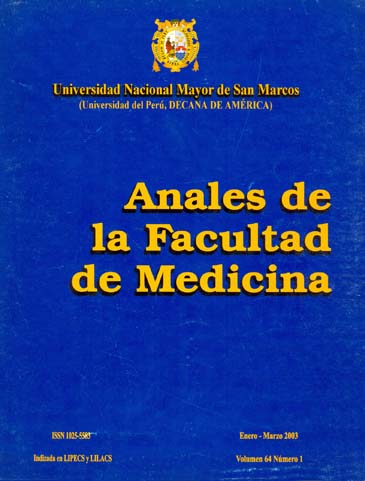Infantile obesity: anthropometric and biochemical characteristics
DOI:
https://doi.org/10.15381/anales.v64i1.1415Keywords:
Obesity, child health, hypertriglyceridemia, hypercholesteterolemiaAbstract
Objetive: To determine both anthropometric and biochemical characteristics and relationship in children with exogenous obesity. Material and methods: Fifty 6 to 18 year-old children and adolescents (25 male and 25 female) with body mass index (BMI) over 95 percentile according to Must et al classification were studied. Studies included triceps and subscapular skinfolds, waist circumference, serum total cholesterol (TC) and triglycerides (TG). Dyslipidemia was determined with TC 200 mg/dL and 100 mg/dL in children less than 10 year-old and TG 130 mg/dL for persons above 10 years of age. Children were divided in two groups according to 50 p values for BMI, TS and WC. Average and standard deviation were determined in each group, as well as Pearson correlation for both anthropometric and biochemical indicators. Results: A total of 32,6% and 55,6% of obese children and adolescents presented hypercholesterolemia and hypertriglyceridemia, respectively; 26,1% had mixed dyslipidemia. Statistic significant difference (p< 0.05) was found for anthropometric indicators, as opposed to biochemical indicators. Conclusions: Hypertriglyceridemia was the main problem in obese child. Obesity and dislipidemias could be independent risk factors and not necessarily consequence of the other.Downloads
Published
2003-03-17
Issue
Section
Trabajos originales
License
Copyright (c) 2003 Jaime Pajuelo, Jesús Rocca, Marco Gamarra

This work is licensed under a Creative Commons Attribution-NonCommercial-ShareAlike 4.0 International License.
Those authors who have publications with this magazine accept the following terms:
- Authors will retain their copyrights and guarantee the journal the right of first publication of their work, which will be simultaneously subject to Creative Commons Attribution License that allows third parties to share the work as long as its author and its first publication this magazine are indicated.
- Authors may adopt other non-exclusive licensing agreements for the distribution of the version of the published work (eg, deposit it in an institutional electronic file or publish it in a monographic volume) provided that the initial publication in this magazine is indicated.
- Authors are allowed and recommended to disseminate their work over the Internet (eg: in institutional telematic archives or on their website) before and during the submission process, which It can produce interesting exchanges and increase quotes from the published work. (See El efecto del acceso abierto ).
How to Cite
1.
Pajuelo J, Rocca J, Gamarra M. Infantile obesity: anthropometric and biochemical characteristics. An Fac med [Internet]. 2003 Mar. 17 [cited 2025 Jun. 4];64(1):21-6. Available from: https://revistasinvestigacion.unmsm.edu.pe/index.php/anales/article/view/1415



